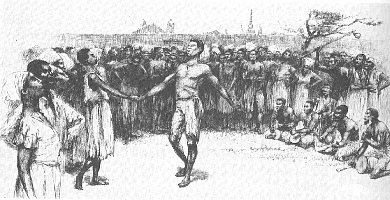by Kael Moffat
.jpg) |
| William P. Gottlieb's iconic portrait of Billie Holiday, taken at the famous Downbeat Club in New York, 1947 (image from the Library of Congress, Public Domain) |
 |
| Cassandra Wilson (image by Scott Penner from Wikimedia Commons, CC BY-SA) |
What made Holiday such an influential artist is the fact that she approached singing in the same way that great soloists like trumpeter Louis Armstrong, pianist Count Basie, and saxophonist Lester Young (one of Holiday's closest friends until they had a falling out just a couple years before both of them passed away). Though she stayed true to the lyrics of the song, she regarded the notes and the rhythms of the lyrics open to interpretation, subject to the particular mood of the performance and her emotional state. Sometimes, she would sing on the beat, but she often sang slightly behind the beat to create and release tension, the way an instrumentalist stretches time and snaps it back for effect. By taking this approach, her performances offered an incredibly intimate expression of her deepest sense of self as an artist, as an African American, and as a woman. Even now (even especially now), she is most admired for her emotional honesty.
One of Holiday's greatest songs was "Strange Fruit," an incredibly rich and understated protest about the unbearably cruel treatment of African Americans in the South. In the Thirties, Fourties, and Fifties lynching was still an every-day fact of life in a region that had not been able to let go of it's violently racial heritage. The song was originally written by Abel Merropol, a Jewish New York school teacher who was appalled by the racial violence in America. He published the lyrics as a poem and later set it to music with the help of his wife. Holiday was introduced to the song two years after its publication and recorded it in 1939 and again in 1944. (5)
Southern trees bear strange fruit,Here's a clip of Holiday's version of the song:
Blood on the leaves and blood at the root,
Black bodies swinging in the southern breeze,
Strange fruit hanging from the poplar trees.
Pastoral scene of the gallant south,
The bulging eyes and the twisted mouth,
Scent of magnolias, sweet and fresh,
Then the sudden smell of burning flesh.
Here is fruit for the crows to pluck,
For the rain to gather, for the wind to suck,
For the sun to rot, for the trees to drop,
Here is a strange and bitter crop. (6)
Cassandra Wilson, has also recorded a rather haunting version of the song:
Holiday's impact on her listeners was memorialized in John O'Hara's poem on her death, "The Day Lady Died," which is a play on her nickname, Lady Day:
It is 12:20 in New York a Fridaythree days after Bastille day, yesit is 1959 and I go get a shoeshinebecause I will get off the 4:19 in Easthamptonat 7:15 and then go straight to dinnerand I don’t know the people who will feed meI walk up the muggy street beginning to sunand have a hamburger and a malted and buyan ugly NEW WORLD WRITING to see what the poetsin Ghana are doing these daysI go on to the bankand Miss Stillwagon (first name Linda I once heard)doesn’t even look up my balance for once in her lifeand in the GOLDEN GRIFFIN I get a little Verlainefor Patsy with drawings by Bonnard although I dothink of Hesiod, trans. Richmond Lattimore orBrendan Behan’s new play or Le Balcon or Les Nègresof Genet, but I don’t, I stick with Verlaineafter practically going to sleep with quandarinessand for Mike I just stroll into the PARK LANELiquor Store and ask for a bottle of Strega andthen I go back where I came from to 6th Avenueand the tobacconist in the Ziegfeld Theatre andcasually ask for a carton of Gauloises and a cartonof Picayunes, and a NEW YORK POST with her face on itand I am sweating a lot by now and thinking ofleaning on the john door in the 5 SPOTwhile she whispered a song along the keyboardto Mal Waldron and everyone and I stopped breathing (7)
1. http://www.nytimes.com/learning/general/onthisday/bday/0407.html
2. Ellis Marsalis, pianist and father of world-renowned Wynton and Branford Marsalis, has an active career that spans all the way back to the 1940s. Wynton Marsalis, by the way, is still the only person to have ever won Grammy Awards for best classical and jazz albums in the same year (1989).
3. http://www.npr.org/2015/04/05/397321378/cassandra-wilson-couldnt-wait-to-reinvent-the-billie-holiday-songbook
4. This is not to entirely dismiss the Andrews Sisters. They were fantastic vocalists and high-caliber musicians and their recordings still hold up very well. In fact, contemporary vocal groups could still learn a thing or two from them.
5. In the jazz and blues world, re-recording songs is not all that unusual. Some contemporary rock/pop singers do it as well. Sting, for example, has recorded "Shadows in the Rain" as a member of The Police (https://www.youtube.com/watch?v=FR2TAdDiOC) and as a solo artist (https://youtu.be/H2h8ZqMe0TY).
6. http://www.historyisaweapon.com/defcon1/fruitholiday.html
7. http://www.poetryfoundation.org/poems-and-poets/poems/detail/42657






.jpg/800px-Louis_Armstrong_(1955).jpg)
